Market Overview
The Global Neural Network Market is projected to reach USD 45.5 billion in 2025 and is expected to grow rapidly to USD 515.9 billion by 2034, registering a strong CAGR of 31.0%. This surge reflects accelerating adoption of deep learning models, AI accelerators, cloud based neural computing, advanced machine learning architectures and enterprise scale intelligent automation across key industries.
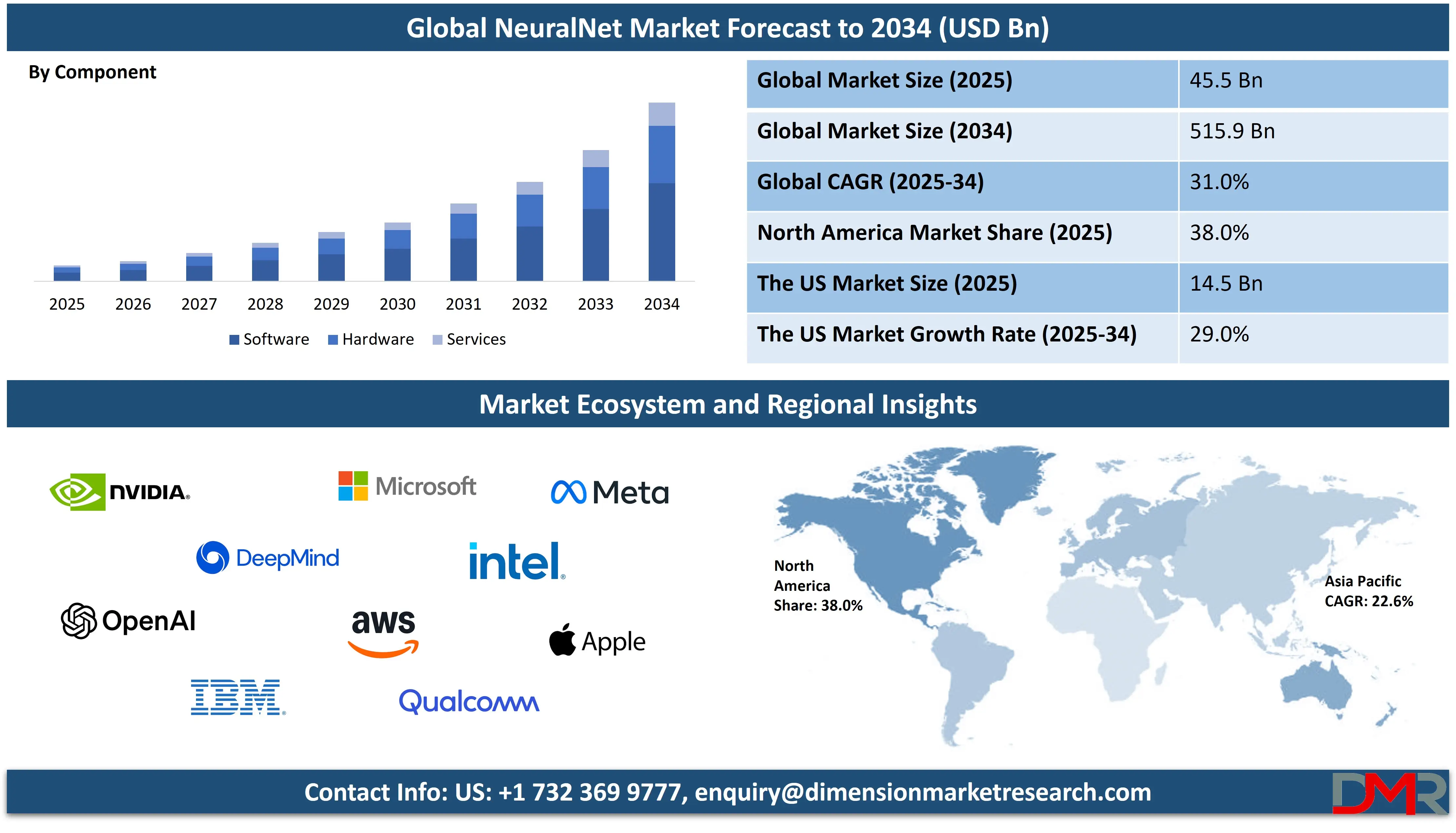
A neural network is a computational system inspired by the interconnected neuron structures of the human brain where layers of nodes process information by identifying relationships within data through weighted connections and activation functions. Neural networks learn by adjusting these weights during training which enables them to recognize complex patterns solve prediction problems and make autonomous decisions across domains such as language understanding image recognition forecasting robotics and intelligent automation. Their adaptability scalability and ability to learn from large datasets make them central to modern
artificial intelligence powering advancements in generative models reinforcement learning and self supervised learning.
The global neural network market refers to the globally ecosystem of technologies solutions and services built around the development training deployment and optimization of neural network models. This market includes hardware accelerators software frameworks algorithmic innovations and cloud or edge platforms that support advanced neural computations. Growth is driven by increasing enterprise adoption of deep learning applications across sectors such as healthcare finance telecom retail autonomous systems and industrial automation where neural networks deliver high accuracy insights and enable real time decision making.
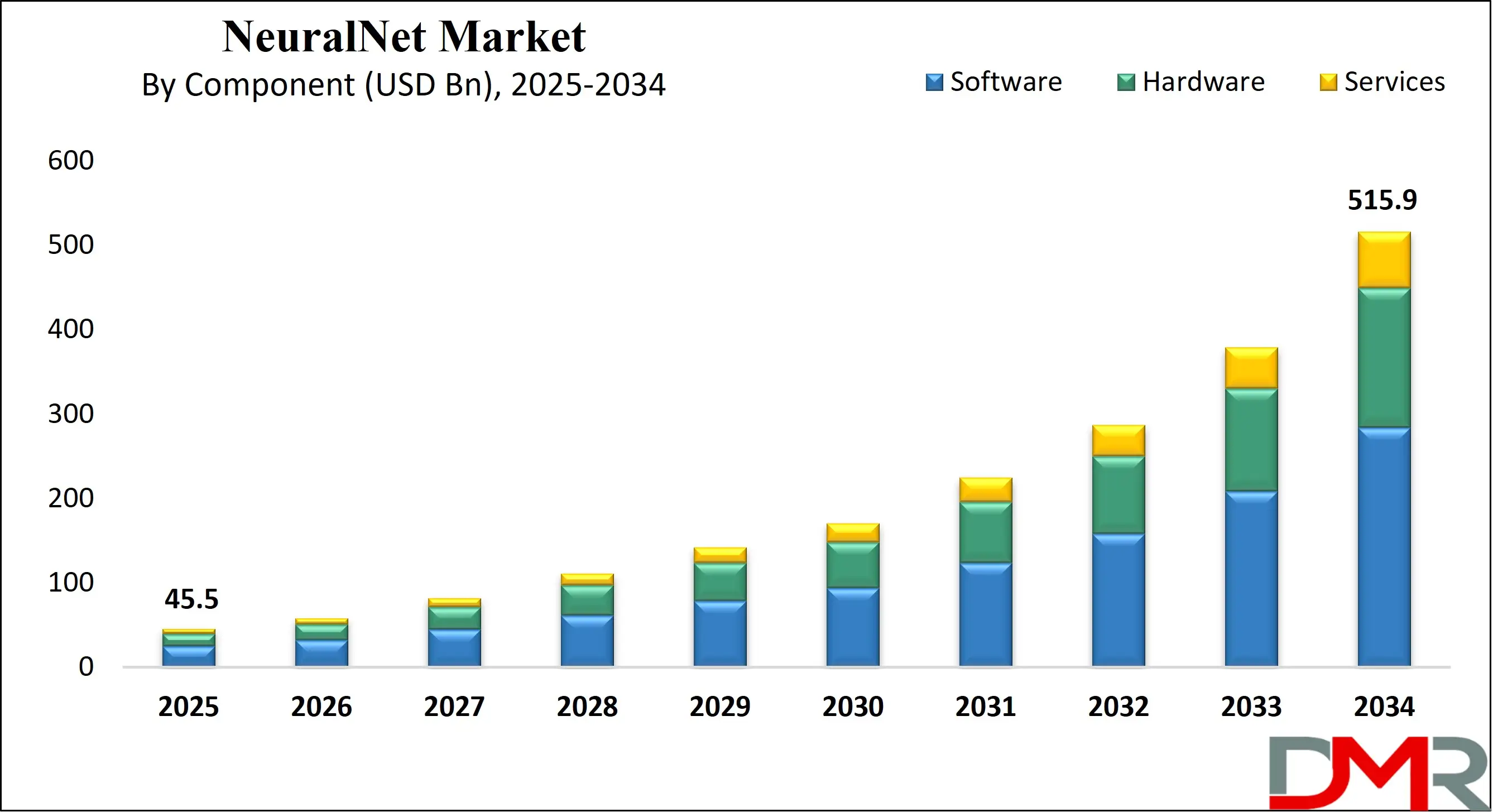
The market also covers commercial demand for neural architectures including convolutional networks recurrent models transformer based systems and generative AI frameworks that support language understanding computer vision and multimodal intelligence. Expanding availability of AI chips increasing use of large scale training datasets and continuous improvements in distributed computing architectures further strengthen this global ecosystem making neural networks a core component of next generation digital transformation strategies.
The US NeuralNet Market
The U.S. NeuralNet market size is projected to be valued at USD 14.5 billion by 2025. It is further expected to witness subsequent growth in the upcoming period, holding USD 144.2 billion in 2034 at a CAGR of 29.0%.
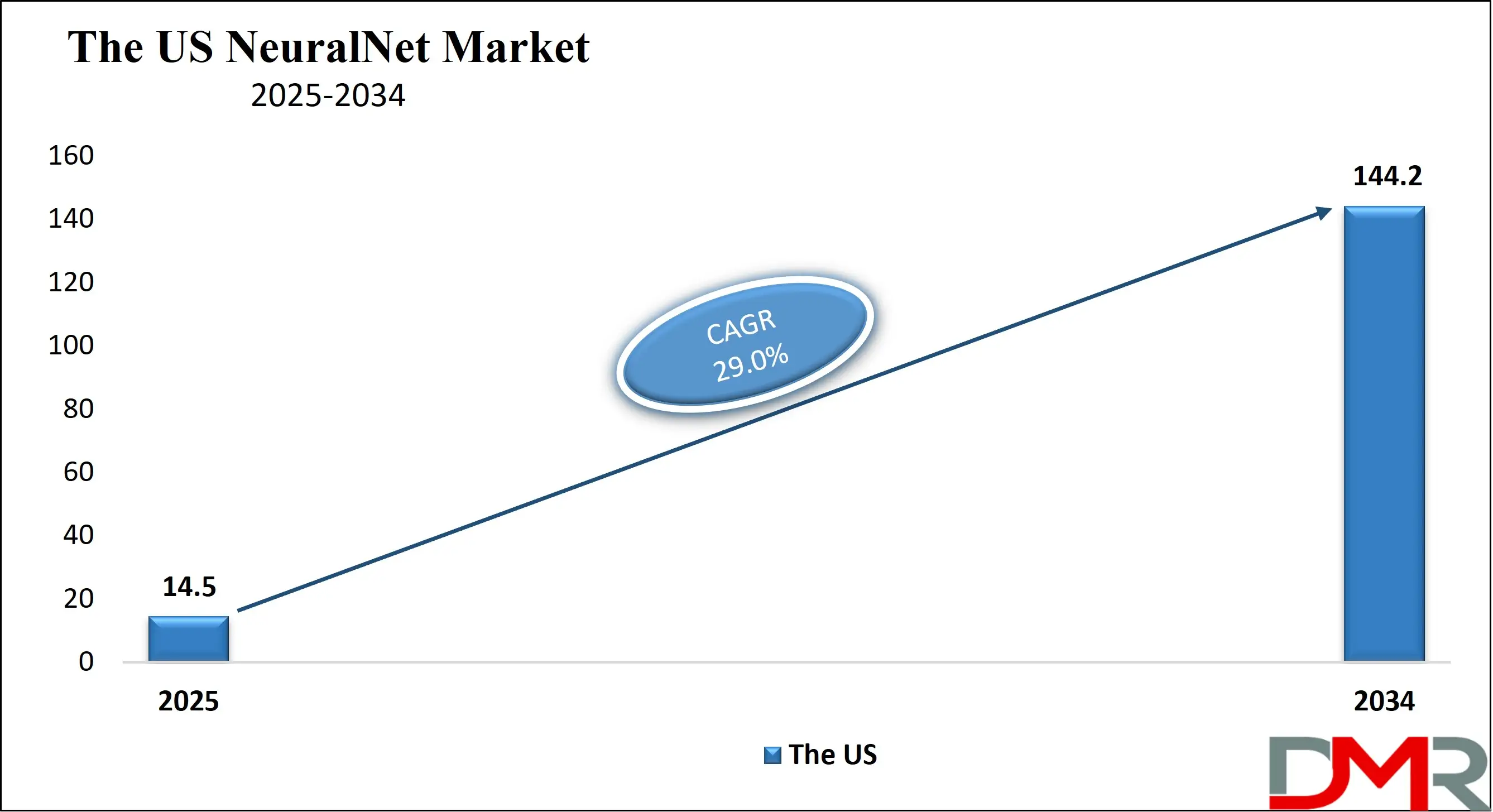
The US neural network market is expanding rapidly as enterprises accelerate adoption of deep learning platforms advanced machine learning models and AI driven automation across critical industries. Growing investment in AI infrastructure including GPUs NPUs cloud based neural compute clusters and edge intelligence systems is driving large scale deployment of neural architectures for applications in predictive analytics computer vision fraud detection and natural language processing. US technology leaders research institutions and hyperscale cloud providers are continuously enhancing neural training efficiency through optimized frameworks distributed learning environments multimodal AI and generative model innovations which further strengthen the domestic ecosystem.
In addition to technological maturity the US market benefits from strong commercial demand in healthcare finance defense retail autonomous mobility and industrial automation where neural networks enable precise decision making pattern recognition and real time data processing. Government backed AI initiatives rising venture capital funding and rapid integration of neural models into enterprise workflows are creating a robust growth environment.
The increasing need for scalable AI infrastructure responsible AI governance high performance computing and advanced neural architectures such as transformer models reinforcement learning systems and hybrid neural engines positions the US as one of the most dominant and innovation driven neural network markets globally.
Europe NeuralNet Market
Europe’s neural network market, valued at approximately USD 11.8 billion in 2025, reflects a rapidly accelerating shift toward AI-driven digital transformation across major economies such as Germany, France, the UK, and the Nordics. This strong regional momentum is fueled by growing adoption of deep learning systems in manufacturing automation, autonomous mobility development, healthcare diagnostics, and financial analytics.
Supportive regulatory frameworks under the EU’s AI Act, combined with large-scale public funding programs for high-performance computing and AI research, further strengthen Europe’s position as a key contributor to global neural network innovation. Enterprises across the region are increasingly integrating neural architectures to enhance productivity, forecast disruptions, and optimize operations.
The market’s robust CAGR of 27.5% between 2025 and 2034 is propelled by Europe’s expanding AI infrastructure, rapid advances in semiconductor design, and the rise of sovereign cloud and edge-AI ecosystems. Growing investments in ethical AI governance, cybersecurity modernization, and responsible AI deployment encourage wider enterprise adoption of neural technologies. Additionally, Europe’s strong academic and research ecosystem is fostering breakthroughs in multimodal learning, privacy-preserving neural networks, and energy-efficient AI models. As industries accelerate automation and digital intelligence initiatives, Europe’s neural network market is positioned for sustained long-term growth at scale.
Japan NeuralNet Market
Japan’s neural network market, valued at approximately USD 2.7 billion in 2025, is being driven by the country’s strong focus on robotics, industrial automation and advanced computing technologies. Japan’s manufacturing sector continues to integrate deep learning systems for predictive maintenance, precision quality control and autonomous robotics, reflecting a national shift toward high-efficiency smart factories. The government’s investments under its Society 5.0 vision are also accelerating adoption of neural architectures across healthcare, public safety, mobility and financial services. Increasing demand for intelligent imaging, natural language understanding and sensor-driven AI systems further strengthens Japan’s strategic position in the global neural network ecosystem.
With a CAGR of 29.0% from 2025 to 2034, Japan is expected to experience rapid expansion supported by strong R&D capabilities, advanced semiconductor innovation and nationwide digital transformation programs. Growth is further reinforced by rising adoption of edge-AI chips, high-performance computing resources and privacy-preserving neural models suited for regulated industries. Japan’s leadership in humanoid robotics, autonomous mobility research and high-precision electronics is enabling deeper integration of neural networks into both consumer and enterprise applications. As businesses modernize operations and invest in next-generation AI infrastructure, Japan’s neural network market is set to advance steadily and maintain strong long-term momentum.
Global NeuralNet Market: Key Takeaways
- Market Value: The global NeuralNet market size is expected to reach a value of USD 515.9 billion by 2034 from a base value of USD 45.5 billion in 2025 at a CAGR of 31.0%.
- By Type Analysis: Deep Neural Networks (DNNs) are anticipated to dominate the type segment, capturing 45.0% of the total market share in 2025.
- By Deployment Mode Segment Analysis: Cloud Deployment will account for the maximum share in the deployment mode segment, capturing 64.0% of the total market value.
- By Component Segment Analysis: Software will dominate the component segment, capturing 55.0% of the market share in 2025.
- By Application Segment Analysis: Computer Vision applications are expected to maintain their dominance in the application segment, capturing 32.0% of the total market share in 2025.
- By Industry Vertical Segment Analysis: IT & Telecom will dominate the industry vertical segment, capturing 27.0% of the market share in 2025.
- Regional Analysis: North America is anticipated to lead the global NeuralNet market landscape with 38.0% of total global market revenue in 2025.
- Key Players: Some key players in the global NeuralNet market are NVIDIA, Google DeepMind, OpenAI, IBM, Microsoft, Amazon Web Services (AWS), Meta AI, Intel, Qualcomm, Apple, Huawei, Baidu, Tencent AI Lab, HPE, and Others.
Global NeuralNet Market: Use Cases
- Healthcare Diagnostics and Clinical Decision Support: Neural networks are transforming healthcare by enabling advanced medical imaging analysis, early disease detection and precision diagnostics. Deep learning models interpret X-rays, MRIs and CT scans with high accuracy while predictive algorithms assist clinicians in identifying risk patterns and recommending personalized treatment plans. Hospitals use neural engines for real time patient monitoring, anomaly detection and drug discovery workflows, accelerating clinical outcomes and reducing diagnostic errors through intelligent automation and data-driven insights.
- Financial Fraud Detection and Risk Analytics: Financial institutions rely on neural architectures to detect fraudulent transactions, assess credit risk and forecast market behavior using pattern recognition and real time anomaly detection. Deep learning systems analyze massive datasets including customer activity logs, payment trails and trading signals to reveal hidden correlations and emerging threats. Banks and fintech firms deploy neural networks for algorithmic trading, compliance monitoring and anti-money laundering processes, improving security and operational efficiency while reducing financial exposure.
- Autonomous Mobility and Intelligent Transportation: Neural networks power core functions in autonomous vehicles, drones and smart mobility systems by enabling real time perception, navigation and object detection. Convolutional and transformer models process sensor data from cameras, LiDAR and radar to support lane identification, obstacle avoidance and route optimization. Transportation operators use neural-based simulations predictive maintenance engines and AI-driven traffic analytics to improve safety, reduce downtime and enhance overall mobility performance.
- Retail Personalization and Customer Experience Optimization: Retailers leverage neural networks to deliver hyper-personalized experiences across digital and in-store environments. Deep learning models analyze shopper behavior, purchase history and sentiment to generate tailored product recommendations dynamic pricing decisions and targeted marketing campaigns. In operational workflows neural intelligence supports demand forecasting inventory optimization and supply chain visibility enabling retailers to improve conversion rates customer engagement and fulfillment accuracy.
Impact of Artificial Intelligence on the global NeuralNet market
Artificial intelligence is reshaping the global neural network market by accelerating innovation, expanding adoption and increasing the commercial value of intelligent computing systems across industries. As AI models grow more complex and data intensive, demand for advanced neural architectures such as transformers, deep learning engines and generative systems continues to surge. AI has significantly improved training efficiency, model accuracy and real time inference capabilities, making neural networks the backbone of next generation automation, predictive analytics, computer vision and natural language processing. Enterprises now invest heavily in AI accelerators, cloud based neural infrastructures and edge AI chips to deploy scalable and cost effective neural solutions at production level.
AI is also expanding the functional scope of the neural network market by enabling multimodal intelligence, self supervised learning, reinforcement learning and hybrid neural approaches that support a broader range of applications across healthcare, finance, autonomous mobility, cybersecurity and industrial automation. The shift toward AI driven decision making and digital transformation has strengthened global demand for high performance GPUs, NPUs and distributed training frameworks. As organizations pursue efficiency, personalization and automation, AI amplifies the strategic relevance of neural networks, positioning them as a critical engine for economic growth, competitive advantage and long term technological progress.
Global NeuralNet Market: Stats & Facts
- U.S. National Institute of Standards and Technology (NIST)
- In 2023, NIST recorded a 22 percent increase in federal AI testbed usage for machine learning and neural network model validation.
- In 2024, AI risk-management framework adoption rose by 31 percent across federal agencies implementing neural network systems.
- In 2025, NIST reported that deep learning benchmarking participation from government-supported labs grew by 27 percent.
- U.S. Department of Energy (DOE)
- DOE noted that neural network–driven scientific computing workloads on national supercomputers grew by 29 percent in 2023.
- In 2024, DOE-funded AI energy-efficiency projects using neural networks expanded by 35 percent.
- In 2025, DOE highlighted a 40 percent jump in neural network applications for climate modeling and fusion research.
- European Union Cybersecurity Agency (ENISA)
- ENISA noted a 19 percent rise in security frameworks addressing neural network vulnerabilities in 2023.
- In 2024, reporting of adversarial attacks on neural models rose by 21 percent.
- In 2025, public infrastructure deployments using hardened neural architectures increased by 28 percent.
- China Ministry of Industry and Information Technology (MIIT)
- China reported a 30 percent rise in AI engineering projects using neural networks in 2023.
- In 2024, national AI infrastructure computing capacity grew by 45 percent due to neural model training demands.
- In 2025, deployment of neural network chips in commercial applications increased by 52 percent.
- Japan Ministry of Internal Affairs and Communications (MIC)
- Japan saw a 15 percent increase in enterprise neural network usage in 2023.
- In 2024, AI-driven automation powered by neural systems grew by 21 percent in manufacturing.
- In 2025, national research programs reported a 28 percent expansion in neural network model experiments.
- India Ministry of Electronics and Information Technology (MeitY)
- India recorded a 19 percent surge in AI and neural computing projects under Digital India in 2023.
- In 2024, government AI centres reported a 26 percent rise in neural network-based analytics deployments.
- In 2025, national AI skilling participation related to neural networks increased by 34 percent.
- South Korea Ministry of Science and ICT (MSIT)
- Neural network chipset R&D programs expanded by 22 percent in 2023.
- In 2024, South Korea’s AI infrastructure capacity for deep learning grew by 30 percent.
- In 2025, neural network adoption in public-sector smart city programs increased by 38 percent.
- Singapore Smart Nation Office
- AI-based neural analytics in public transport increased by 16 percent in 2023.
- In 2024, national digital services using neural models grew by 24 percent.
- In 2025, real-time neural network deployment in government systems expanded by 33 percent.
Global NeuralNet Market: Market Dynamics
Global NeuralNet Market: Driving Factors
Rising Enterprise Adoption of Deep Learning and Intelligent Automation
Enterprises across sectors such as healthcare, BFSI, telecom, retail and manufacturing are rapidly integrating deep learning and advanced neural architectures to automate workflows, improve prediction accuracy and optimize decision making. The surge in AI-driven analytics, computer vision tools, natural language understanding and intelligent process automation is expanding demand for scalable neural engines, cloud AI infrastructure and edge neural processing units. This shift toward data-centric operations strongly accelerates the growth of the global neural network market.
Expansion of High-Performance AI Hardware and Accelerated Computing
The development of specialized AI chips including GPUs, TPUs, NPUs and neuromorphic processors is enabling faster training, reduced latency and large-scale neural model deployment. Increasing investment in high performance computing clusters, distributed training platforms and AI-optimized hardware accelerators has significantly boosted the efficiency of transformer models, generative AI frameworks and multimodal neural systems. This technological evolution is a major growth catalyst for the market.
Global NeuralNet Market: Restraints
High Computational Costs and Infrastructure Complexity
Training modern neural architectures especially large generative and transformer models requires advanced hardware, extensive GPU clusters and expensive cloud resources. This raises operational costs for small and mid-size enterprises and creates adoption barriers. Complex model optimization, energy consumption and technical skill shortages further limit widespread deployment of neural systems.
Data Privacy, Regulatory Pressure and Ethical Concerns
Neural networks rely heavily on large datasets, which increases challenges related to data protection, compliance and responsible AI governance. Concerns around bias, transparency, secure data handling and model explainability limit deployment in regulated sectors. Evolving global regulations create uncertainty for enterprises adopting neural solutions, slowing market expansion.
Global NeuralNet Market: Opportunities
Growth of Edge AI and On-Device Neural Processing
The increasing need for real time inference, low latency analytics and private on-device computation is creating strong opportunities for edge neural networks. Industries such as automotive, consumer electronics, robotics and smart manufacturing are adopting lightweight neural models and AI chips optimized for local processing. This trend opens new revenue streams for model compression, edge accelerators and decentralized AI architectures.
Rapid Adoption of Generative AI and Multimodal Neural Models
Generative AI, diffusion models and multimodal neural systems are unlocking massive opportunities across design, content creation, simulation, drug discovery and human-machine interaction. Enterprises are experimenting with domain-specific generative engines, large language models and hybrid neural frameworks that combine vision, language and sensory data. This expanding application ecosystem is set to create new commercial growth avenues.
Global NeuralNet Market: Trends
Rise of Self-Supervised Learning and Foundation Models
Self-supervised neural architectures and large foundation models are becoming central to enterprise AI strategies. These models reduce dependency on labeled data, improve generalization and support multiple downstream tasks from a single pretrained architecture. Their adoption is accelerating integration of neural systems into real world workflows and digital transformation initiatives.
Integration of Neural Networks with Robotics and Autonomous Systems
Neural networks are increasingly embedded in autonomous vehicles, industrial robots, drones and intelligent machines, enabling advanced perception, navigation and decision control. The combination of sensor fusion, reinforcement learning and deep neural inference is transforming mobility, manufacturing and logistics. This trend is pushing the market toward more intelligent, self-learning and adaptive neural systems.
Global NeuralNet Market: Research Scope and Analysis
By Type Analysis
Deep Neural Networks are expected to dominate the type segment with a projected 45.0% share in 2025, driven by their versatility, scalability and ability to analyze large and complex datasets across multiple industries. Enterprises increasingly rely on DNN architectures for tasks such as predictive analytics, natural language understanding, fraud detection and advanced pattern recognition. Their multilayered structure enables high-accuracy learning, making them the preferred choice for deep learning applications deployed in cloud AI platforms, enterprise intelligence systems and edge processing solutions. The rapid rise of generative AI, transformer-based models and large foundation models further reinforces the dominance of DNNs, as these advanced architectures depend heavily on deep computational layers and high-performance neural processing.
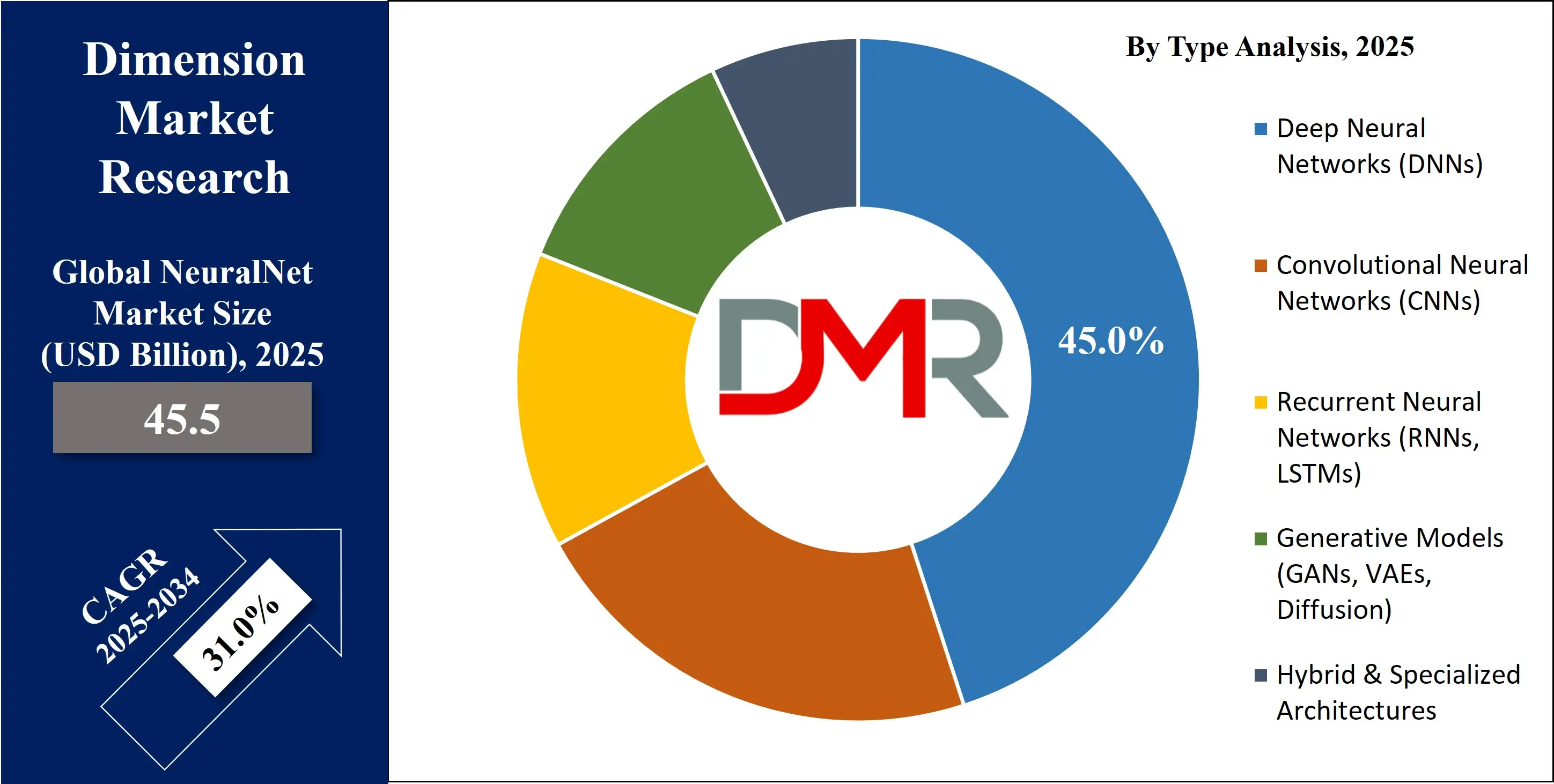
Convolutional Neural Networks also represent a vital segment of the global neural network market due to their strong capability in processing and understanding visual information. CNNs are widely used in image classification, medical imaging diagnostics, autonomous vehicle perception, retail footfall analytics and intelligent surveillance systems due to their ability to extract spatial features with precision. Their convolutional filters efficiently detect objects, patterns and anomalies in real time, which supports growing adoption in robotics, industrial quality inspection, smart mobility and security technologies. As computer vision continues to expand across sectors, CNNs maintain robust demand and remain an essential component of the broader neural network ecosystem.
By Deployment Mode Analysis
Cloud deployment is expected to capture 64.0% of the total market value due to the rising need for scalable, flexible and cost-efficient infrastructure to support large neural models and high-volume data processing. Enterprises are increasingly shifting neural workloads to cloud platforms because they offer distributed training environments, advanced AI accelerators, seamless model updates and easy integration with big data systems. Cloud providers also supply specialized AI tools, pretrained models and automated machine learning pipelines that significantly reduce deployment time and operational complexity. As organizations adopt generative AI, multimodal intelligence and deep learning applications at scale, cloud-based neural computing continues to expand, driven by lower upfront costs, faster experimentation cycles and the ability to handle massive computational demands.
On-premise deployment remains important for industries that prioritize data security, regulatory compliance and full control over AI infrastructure. Sectors such as banking, healthcare, government and defense rely on on-premise neural networks to process sensitive information within secured local environments. This deployment mode supports customized hardware setups including private GPU clusters, high-performance servers and specialized neural accelerators designed for mission-critical applications. While on-premise solutions involve higher infrastructure costs, they provide predictable performance, reduced latency and enhanced data governance, making them suitable for organizations that require strict oversight of neural model training and inference workflows.
By Component Analysis
Software is projected to dominate the component segment with a 55.0% share in 2025 as organizations increasingly rely on advanced neural frameworks, AI development platforms and model management tools to build and deploy intelligent applications. The rapid adoption of deep learning libraries, automated machine learning systems, training pipelines and cloud-native AI platforms has accelerated software demand across industries. Enterprises prefer flexible and modular software stacks that support model experimentation, hyperparameter tuning, data preprocessing and real-time inference. The growing use of generative AI models, foundation models and multimodal neural architectures also requires sophisticated software ecosystems capable of handling large datasets, distributed training, continuous integration and scalable deployment—further reinforcing the dominance of software in this market.
Hardware remains a critical component of the neural network landscape as the performance of modern AI systems heavily depends on powerful processing units and optimized computing infrastructure. GPUs, TPUs, NPUs and AI-specific accelerators enable high-speed training, low-latency inference and energy-efficient neural computations. Industries adopting autonomous systems, robotics, advanced analytics and computer vision applications rely on high-performance hardware to support complex neural workloads. With the rise of large-scale transformer models and edge AI devices, demand for specialized chips, high-bandwidth memory, AI servers and embedded processors continues to grow. This makes hardware an essential foundation for enabling robust neural operations across cloud, on-premise and edge environments.
By Application Analysis
Computer vision applications are expected to maintain their lead with a 32.0% share in 2025 as industries increasingly adopt image-based intelligence for automation, safety and operational efficiency. Neural networks powering computer vision enable real-time object detection, facial recognition, medical imaging analysis, quality inspection, autonomous navigation and security monitoring. Retailers use vision models for customer behavior analysis, manufacturers deploy them for defect detection and mobility companies use them for advanced driver-assistance systems. The growth of smart cities, autonomous vehicles, robotics and surveillance technologies continues to strengthen demand for high-accuracy vision systems, pushing computer vision to remain the most widely adopted neural network application across global markets.
Natural language processing applications also represent a major growth area as neural architectures transform how businesses interact with text, speech and human communication. NLP enables sentiment analysis, chatbots, voice assistants, document automation, language translation and intelligent search systems. The rise of transformer-based models, generative AI and large language models has significantly elevated the capabilities of NLP, allowing enterprises to analyze unstructured data at scale and deliver more personalized and context-aware user experiences. As sectors such as customer service, healthcare, finance and e-commerce rely more heavily on conversational AI and real-time language understanding, NLP continues to gain momentum within the broader neural network application ecosystem.
By Industry Vertical Analysis
IT and telecom are projected to lead the industry vertical segment with a 27.0% share in 2025 as organizations in this sector increasingly deploy neural networks to enhance network optimization, cybersecurity, predictive maintenance and intelligent service delivery. Telecom operators rely on neural models for traffic forecasting, anomaly detection, automated troubleshooting and 5G network orchestration. In the IT domain, neural architectures power cloud automation, software intelligence, data center optimization and advanced analytics workflows. The rapid adoption of AI-driven digital transformation, edge computing solutions and hyperscale cloud infrastructures strengthens the dominance of IT and telecom as they continue to integrate deep learning, multimodal AI and generative neural applications into core operational systems.
BFSI remains a crucial segment within the neural network market due to its strong focus on real-time decision making, risk mitigation and fraud prevention. Banks and financial institutions employ neural models for credit scoring, fraud detection, algorithmic trading, customer personalization and regulatory compliance. Deep learning architectures analyze massive datasets including transaction logs, behavioral patterns and market signals to uncover anomalies and improve forecasting accuracy. Insurers use neural networks for claims automation, underwriting, risk assessment and customer profiling. As digital banking adoption increases and financial services demand more secure and intelligent automation, BFSI continues to expand its reliance on neural network technologies to strengthen operational efficiency and customer trust.
The NeuralNet Market Report is segmented on the basis of the following:
By Type
- Deep Neural Networks (DNNs)
- Convolutional Neural Networks (CNNs)
- Recurrent Neural Networks (RNNs, LSTMs)
- Generative Models (GANs, VAEs, Diffusion)
- Hybrid & Specialized Architectures
By Deployment Mode
- Cloud Deployment
- On-Premise Deployment
- Edge Deployment
By Component
- Software
- Hardware
- Services
By Application
- Computer Vision
- Natural Language Processing (NLP)
- Predictive Analytics
- Speech & Audio Processing
- Autonomous Systems
By Industry Vertical
- IT & Telecom
- BFSI
- Healthcare
- Retail & E-commerce
- Manufacturing
- Transportation & Automotive
- Others
Global NeuralNet Market: Regional Analysis
Region with the Largest Revenue Share
North America is expected to lead the global NeuralNet market in 2025, capturing 38.0% of total globally revenue due to its advanced AI infrastructure, strong investment ecosystem, and rapid enterprise adoption. The region benefits from a mature cloud computing landscape, cutting-edge research institutions, and major tech giants that continuously drive innovation in neural network development and deployment. Its early adoption across sectors such as healthcare, finance, automotive, and defense further strengthens its leadership position. Additionally, government initiatives supporting AI scalability, data modernization, and ethical AI frameworks contribute to the region’s dominance, making North America the central hub for NeuralNet innovation and commercialization in 2025.
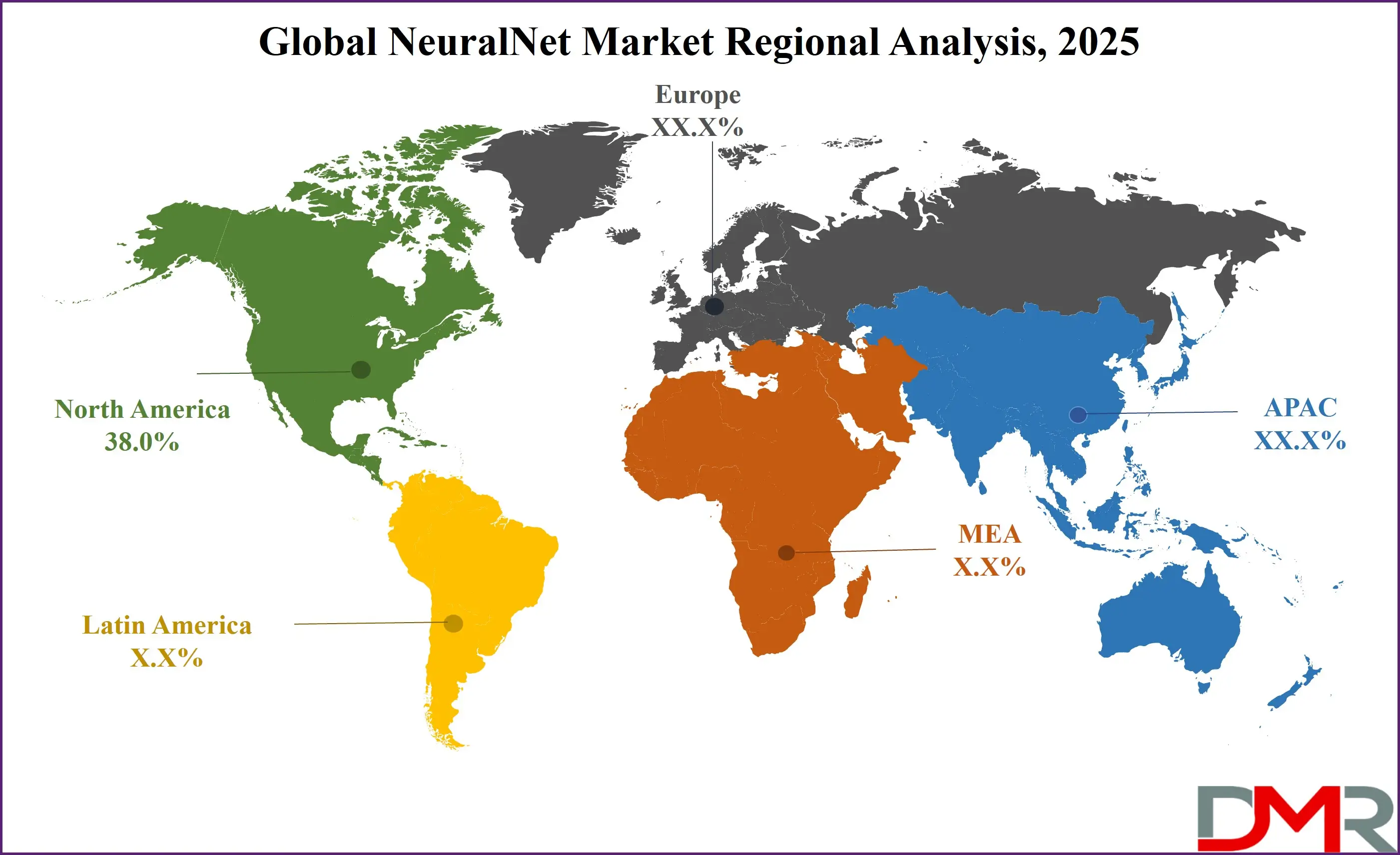
Region with significant growth
Asia Pacific is emerging as the region with the most significant growth in the global neural network market, driven by massive investments in AI infrastructure, rapid digital transformation and expanding adoption of intelligent automation across industries. Countries such as China, Japan, South Korea and India are accelerating deployment of deep learning systems, generative AI models, autonomous technologies and cloud-based neural computing. Strong government support, a large pool of AI talent and expanding semiconductor manufacturing capabilities further strengthen the region’s competitive position. With rising demand for advanced analytics, smart city solutions, edge AI devices and enterprise-scale neural applications, Asia Pacific continues to experience the fastest growth trajectory in the global market.
By Region
North America
Europe
- Germany
- The U.K.
- France
- Italy
- Russia
- Spain
- Benelux
- Nordic
- Rest of Europe
Asia-Pacific
- China
- Japan
- South Korea
- India
- ANZ
- ASEAN
- Rest of Asia-Pacific
Latin America
- Brazil
- Mexico
- Argentina
- Colombia
- Rest of Latin America
Middle East & Africa
- Saudi Arabia
- UAE
- South Africa
- Israel
- Egypt
- Rest of MEA
Global NeuralNet Market: Competitive Landscape
The global neural network market features a highly competitive and innovation-driven landscape characterized by rapid advancements in deep learning architectures, AI hardware accelerators and cloud-based neural computing platforms. Competition intensifies as technology providers focus on expanding capabilities in generative AI, multimodal intelligence, edge neural processing and high-performance computing to meet enterprise demand for scalable and efficient AI solutions.
Companies are increasingly investing in specialized chips, distributed training frameworks, automated machine learning tools and pretrained foundation models to differentiate their offerings. The market is also shaped by strategic partnerships, ecosystem integrations, R&D collaborations and continual improvements in model accuracy, energy efficiency and deployment flexibility. As adoption accelerates across industries, the competitive environment remains dynamic with a strong emphasis on innovation, speed, and AI-first product development.
Some of the prominent players in the global NeuralNet market are
- NVIDIA
- Google DeepMind
- OpenAI
- IBM
- Microsoft
- Amazon Web Services (AWS)
- Meta AI
- Intel
- Qualcomm
- Apple
- Huawei
- Baidu
- Tencent AI Lab
- HPE (Hewlett Packard Enterprise)
- Graphcore
- Cerebras Systems
- Synopsys
- Siemens
- Oracle
- SAP
- Other Key Players
Global NeuralNet Market: Recent Developments
- October 2025: NXP completed the acquisition of Kinara, a pioneer in low-power discrete neural processing units (DNPUs) for edge-AI applications.
- May 2025: TensorWave, a company building efficient infrastructure for training neural networks, raised USD 100 million in a Series A led by Magnetar and AMD Ventures to scale GPU-based clusters.
- April 2025: Thinking Machines Lab, an AI startup co-founded by ex–OpenAI CTO Mira Murati, raised USD 2 billion at a valuation of USD 12 billion to build its next-generation neural reasoning and agentic AI platform.
Report Details
| Report Characteristics |
| Market Size (2025) |
USD 45.5 Bn |
| Forecast Value (2034) |
USD 515.9 Bn |
| CAGR (2025–2034) |
31.0% |
| The US Market Size (2025) |
USD 14.5 Bn |
| Historical Data |
2019 – 2024 |
| Forecast Data |
2026 – 2034 |
| Base Year |
2024 |
| Estimate Year |
2025 |
| Report Coverage |
Market Revenue Estimation, Market Dynamics, Competitive Landscape, Growth Factors and etc. |
| Segments Covered |
By Type (Deep Neural Networks DNNs, Convolutional Neural Networks CNNs, Recurrent Neural Networks RNNs LSTMs, Generative Models GANs VAEs Diffusion, Hybrid and Specialized Architectures); By Deployment Mode (Cloud Deployment, On-Premise Deployment, Edge Deployment); By Component (Software, Hardware, Services); By Application (Computer Vision, Natural Language Processing NLP, Predictive Analytics, Speech and Audio Processing, Autonomous Systems); and By Industry Vertical (IT and Telecom, BFSI, Healthcare, Retail and E-commerce, Manufacturing, Transportation and Automotive, Others). |
| Regional Coverage |
North America – The US and Canada; Europe – Germany, The UK, France, Russia, Spain, Italy, Benelux, Nordic, & Rest of Europe; Asia- Pacific– China, Japan, South Korea, India, ANZ, ASEAN, Rest of APAC; Latin America – Brazil, Mexico, Argentina, Colombia, Rest of Latin America; Middle East & Africa – Saudi Arabia, UAE, South Africa, Turkey, Egypt, Israel, & Rest of MEA |
| Prominent Players |
NVIDIA, Google DeepMind, OpenAI, IBM, Microsoft, Amazon Web Services (AWS), Meta AI, Intel, Qualcomm, Apple, Huawei, Baidu, Tencent AI Lab, HPE, and Others. |
| Purchase Options |
We have three licenses to opt for: Single User License (Limited to 1 user), Multi-User License (Up to 5 Users) and Corporate Use License (Unlimited User) along with free report customization equivalent to 0 analyst working days, 3 analysts working days and 5 analysts working days respectively.z |
Frequently Asked Questions
The global NeuralNet market size is estimated to have a value of USD 45.5 billion in 2025 and is expected to reach USD 515.9 billion by the end of 2034.
The US NeuralNet market is projected to be valued at USD 14.5 billion in 2025. It is expected to witness subsequent growth in the upcoming period as it holds USD 144.2 billion in 2034 at a CAGR of 29.0%.
North America is expected to have the largest market share in the global NeuralNet market, with a share of about 38.0% in 2025.
Some of the major key players in the global NeuralNet market are NVIDIA, Google DeepMind, OpenAI, IBM, Microsoft, Amazon Web Services (AWS), Meta AI, Intel, Qualcomm, Apple, Huawei, Baidu, Tencent AI Lab, HPE, and Others.
The market is growing at a CAGR of 31.0 percent over the forecasted period.